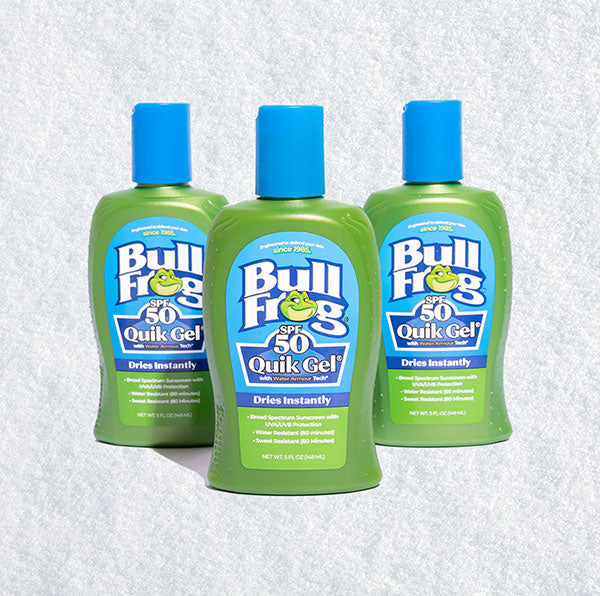
There's a wintertime myth that needs to be smashed. While many of us are "sunscreen smart" during summertime, we wrongly assume that winter's darker skies offer all the protection our skin needs. In truth, the weather report doesn't change our need for sunscreen. Sun damage can occur during any season of the year. What's more, you don't actually need to be exposed to peak sun to experience sun damage. Damaging UV rays can cause premature skin aging, dry skin, painful sunburn, and cancer risks on cloudy, dreary days with overcast conditions.
Do I need to wear sunscreen in the winter? Yes, sunscreen is essential during the winter. This is especially true for people who enjoy skiing, snowboarding, sledding, midwinter jogs, and all other outdoor winter sports. While the sun is technically stronger during summer, there are some surprising factors that increase your risk for sunburn in the winter.
Wearing sunscreen in the winter doesn't have to feel like a chore. In fact, a good wintertime sunscreen can have a luxuriating effect that stops the skin from feeling dry and chapped. Finding the best sunscreen for dry winter skin can help to keep skin moisturized, plump, and free of wrinkles by preventing the loss of moisture that often happens when we spend time outdoors during the winter. Don't let your plan for protecting your family from skin cancer go cold! Take a deeper look at what everyone needs to know about wearing sunscreen in the winter.
Winter Sunscreen Facts, Figures, and Tips
"In the right winter weather conditions, you can sustain sun damage just as easily as during the summer," shares the Skin Cancer Foundation. Both UVB and UVA rays can damage skin throughout the year because their presence remains consistent regardless of the season. UV rays can be especially harmful at high altitudes. Snowy conditions can also amplify the effects of the sun's rays on your skin. Snow reflects up to 80% of the sun's UV light. The reflective relationship between snow and UV rays means that rays effectively hit you twice. According to physicians at the Skin Cancer Foundation, this increases your risks for skin cancer and premature aging. This is essential information for people who enjoy skiing, snowboarding, sledding, skating, or riding snowmobiles.
According to the CDC, there's a risk of exposure to the sun's harmful ultraviolet (UV) rays whenever you're outside during the hours between sunrise and sunset. The greatest risk for sun exposure occurs between 10 a.m. and 4 p.m. Here are some tips for making wintertime sunscreen as effective as possible:
- Use sunscreen with SPF 15 protection or higher. Getting closer to SPF 30 or SPF 50 is preferred.
- Ensure that your sunscreen is a broad-spectrum sunscreen that blocks both UVA and UVB rays.
- Apply sunscreen generously over all exposed skin. While we may be bundled up in heavy clothing during the winter, our ears, nose, necks, hands, lips, and faces are vulnerable.
- Reapply as often as needed.
Sunscreen works best when used in collaboration with appropriate outdoor clothing. If you're preparing for long hours spent enjoying winter sports, it's helpful to cover as much skin with clothing as possible. Sports hats and sunglasses are terrific for blocking UVA and UVA rays. However, clothing doesn't remove the necessity for sunscreen. UV rays easily penetrate many materials. As a result, you may have a false sense of security about your skin being protected from sun damage just because the fabric covers it. Sunscreen also protects you when you remove layers of clothing due to overheating while enjoying outdoor sports in snow-capped settings! Waterproof sunscreen in the winter is important even if you're not going anywhere near the water because people tend to sweat more under heavy winter clothing.
The American Academy of Dermatology estimates that one in five Americans will develop skin cancer in their lifetime. Nearly 100,000 cases of a deadly form of skin cancer called melanoma will be diagnosed this year. Adequate year-round sun protection remains one of the strongest ways to defend your family against the risks of skin cancer, and the good news is that sunscreen is also one of the easiest ways to stay safe.
How Do You Pick the Best Sunscreen for Winter?
There's a little secret about selecting the best sunscreen for winter that can save you time. You don't actually need a particular sunscreen for winter if you're already using the best sunscreen possible for the rest of the year. That's why families trust Bullfrog Quik Spray & Quik Gel Sunscreen SPF 50 as their year-round sunscreen! It turns out that the same beloved sunscreen that's been engineered to defend your skin since 1985 can also help your family have a magical winter without worries.
Free of harmful oxybenzone and octinoxate, Bullfrog Quik Spray & Quik Gel Sunscreen SPF 50 goes on quickly, absorbs instantly, and provides long-lasting protection that never feels goopy, sticky, or heavy. It's also the best sunscreen for dry winter skin for everyone in the family! Use the gel for fast absorbency and the spray for easy application. Both products are enriched with antioxidants and soothing plant extracts and offer broad spectrum UVA/UVB protection so you can have a worry free winter.
Does wintertime mean it’s time to sweat on the slopes? No big deal! Bullfrog's innovative Water Armour TECH technology uses hydrophobic polymer for the longest-lasting water resistance available today. In addition, Bullfrog makes the best sunscreen for dry winter skin because this UVA/UVB formula contains moisturizing elements from botanicals to help skin stay supple without drying, flaking, and chafing in cold weather. There's no room for slacking on sun protection when the air turns chilly. Order yours today!
